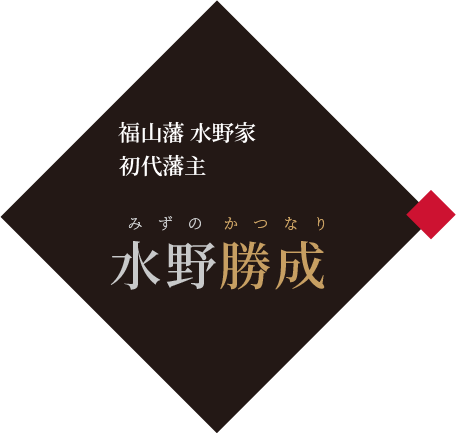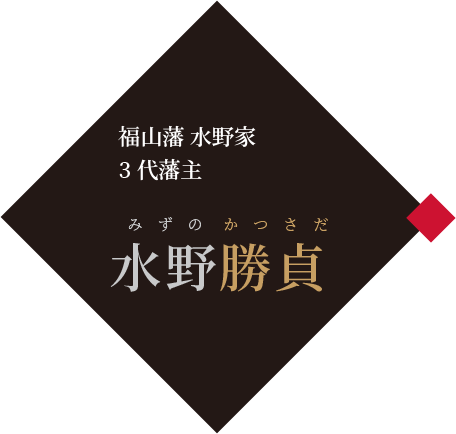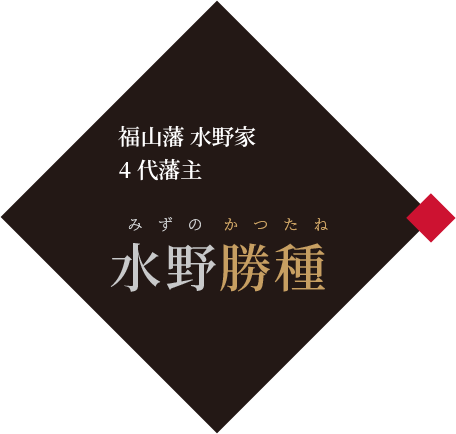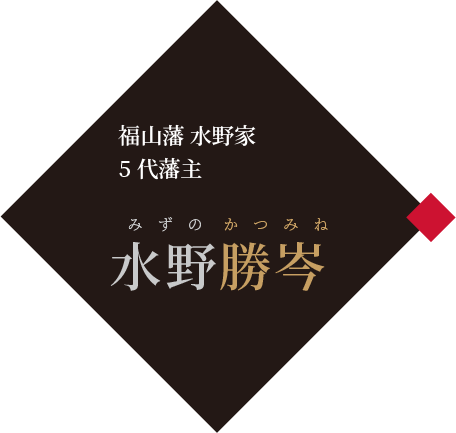About Fukuyama daimyos
Daimyos of the Mizuno family, the Matsudaira family, and the
Abe
family
Term of office
1619 – 1639
Year of birth and death
1564 – 1651
Katsunari was born in 1564 in Mikawa Province (current Aichi Prefecture). Katsunari’s father Tadashige and Odai no kata, Tokugawa Ieyasu’s mother, were sister and brother, thus he and Tokugawa Ieyasu were cousins.
In 1579, he won his first battle in the Seize of Takatenjin Castle in Enshu, but incurred the displeasure of his father during the battle of Komaki and Nagakute in 1584, and was forced to travel around the country. He then wandered around Bingo and Bichu Provinces after having served Toyotomi Hideyoshi, Sasa Narimasa, Konishi Yukinaga, Kato Kiyomasa, Kuroda Nagamasa, and others.
In 1599, he returned to his lord’s service after reconciliation with his father Tadashige under the mediation of Ieyasu. However, after his father Tadashige was assassinated in 1600, he inherited 30,000 koku of his father’s domain in Kariya at age 37. In 1610, he was appointed Governor of Hyuga Province, ranked Jugoinoge, or junior fifth rank, lower grade.
In the Siege of Osaka in 1615, he, as a fierce warrior, fought and defeated Goto Matabei Mototsugu. His achievements were recognized and he was relocated to Yamatokoriyama with 60,000 koku. After Fukushima Masanori’s change of rank, the history of the Fukuyama domain began in 1619 (the fifth year of Genna) when 40,000 koku was added and he was relocated to Bingo Province which was worth 100,000 koku.
After entering Fukuyama, Katsunari worked hard to reclaim the sea and build a castle town at the same time as the construction of Fukuyama Castle. He continued to pursue land reclamation, cultivation, and flood control projects, and to supplement funds for those undertakings, he became the first in the nation to issue domain currencies, and even repaired and rebuilt temples and shrines.
In 1638, despite his old age of 74, he took to the field in the Shimabara Rebellion. In 1639, after the subjugation, he retired from office in favor of his heir Katsutoshi, but continued to cultivate the castle area using his own retirement money. In 1651, he died in Fukuyama at age 88, and was buried at Kenchuji Temple in Teramachi. Katsunari’s life is composed of the first half as a warrior and the second half as a daimyo. His influence is immeasurable, especially after his relocation to Fukuyama, where he laid the foundation. He is truly worthy of being called the founder of Fukuyama.
Term of office
1639 – 1655
Year of birth and death
1598 – 1655
In 1619, his father Katsunari relocated to Fukuyama and entered the old Tomo Castle, which is why he is also called “Lord Tomo”. In 1638, he joined his father Katsunari and his eldest son Iori (Katsusada III) and took to the field in the Shimabara Rebellion where he achieved military exploits. 1639, he succeeded to a family.
Katsutoshi succeeded his father, Katsunari, in the administration of the domain, and was exclusively involved in undertakings such as land reclamation and land cultivation. Katsutoshi’s achievements include the construction of Kasugaike Pond, a reservoir for agriculture, and the Shimbashi Bridge, which later became known as the Momen-bashi Bridge.
Term of office
1655 – 1662
Year of birth and death
1625 – 1662
In 1638, he joined his grandfather Katsunari and his father Katsutoshi and took to the field in the Shimabara Rebellion at age 14. In 1639, he was granted an audience with Shogun Tokugawa Iemitsu as his heir apparent after his father Katsutoshi took over as head of the family. In 1640, he was appointed Governor of Bizen Province, ranked Jugoinoge (junior fifth rank, lower grade).
In 1655, he became the third Mizuno daimyo of the Fukuyama domain. In the same year, he was appointed Governor of Hyuga Province. Although he continued to come and go between Edo and Fukuyama to reign, he died in 1662 at the young age of 38.
Term of office
1663 – 1697
Year of birth and death
1661 – 1697
In 1769, at age 25, he inherited the domain of Masasuke. After assuming the position of daimyo, his challenge in the domain administration was to overcome the financial difficulties that had existed since the previous generation.
Further, the Fukuyama region had experienced a series of bad harvests, and a peasant’s revolt broke out in 1770, the year after he took over the domain. From the end of 1786 to 1787, the Tenmei Famine again led to a peasant’s revolt. Masamichi resigned as Roju after only 11 months in office, after which he began to focus on reforming the domain government.
Term of office
1697 – 1698
Year of birth and death
1697 – 1698
He was born in Fukuyama in 1697. In the same year, he succeeded to a family at just one-year-old, after the sudden death of his father Katsutane. In 1698, he left Fukuyama to visit the capital, but became ill on the way and died in Edo that same year at just two years old.
The Mizuno family was put to an end by the absence of the daimyo, and the Fukuyama domain was ordered to be abolished in accordance with Acts for the Military Houses. The Mizuno family and its vassals were therefore ordered to leave Fukuyama.
Nevertheless, the Mizuno family had a proven record of contribution to the Tokugawa family, and as a result, Katsunaga, Katsunari’s great-grandson (grandson of Katsutada, Katsutoshi’s younger brother) was allowed to succeed the Mizuno family. However, he was only given 10,000 koku in Noto Province (current Ishikawa Prefecture), far from Fukuyama. Later, he was relocated to the Yuki domain, leading to the present history.





